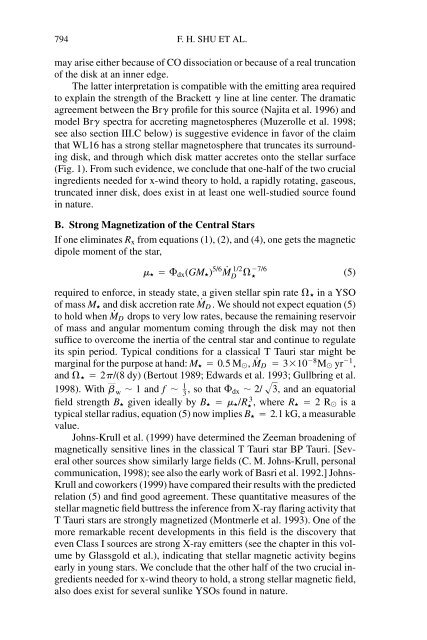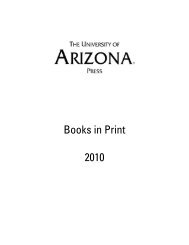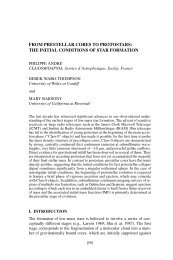x-winds: theory and observations - The University of Arizona Press
x-winds: theory and observations - The University of Arizona Press
x-winds: theory and observations - The University of Arizona Press
Create successful ePaper yourself
Turn your PDF publications into a flip-book with our unique Google optimized e-Paper software.
794 F. H. SHU ET AL.<br />
may arise either because <strong>of</strong> CO dissociation or because <strong>of</strong> a real truncation<br />
<strong>of</strong> the disk at an inner edge.<br />
<strong>The</strong> latter interpretation is compatible with the emitting area required<br />
to<br />
explain the strength <strong>of</strong> the Brackett line at line center. <strong>The</strong> dramatic<br />
agreement between the Br<br />
pr<strong>of</strong>ile for this source (Najita et al. 1996) <strong>and</strong><br />
model Br<br />
spectra for accreting magnetospheres (Muzerolle et al. 1998;<br />
see also section III.C below) is suggestive evidence in favor <strong>of</strong> the claim<br />
that WL16 has a strong stellar magnetosphere that truncates its surround-<br />
ing disk, <strong>and</strong> through which disk matter accretes onto<br />
the stellar surface<br />
(Fig. 1). From such evidence, we conclude that one-half <strong>of</strong> the twocrucial<br />
ingredients needed for x-wind <strong>theory</strong> to hold, a rapidly rotating, gaseous,<br />
truncated inner disk, does exist in at least one well-studied source found<br />
in nature.<br />
B. Strong Magnetization <strong>of</strong> the Central Stars<br />
If one eliminates Rx<br />
from equations (1), (2), <strong>and</strong> (4), one gets the magnetic<br />
dipole moment <strong>of</strong> the star,<br />
.<br />
( ) (5)<br />
5/6 1/2 7/6<br />
dx<br />
GM MD<br />
<br />
required to<br />
enforce, in steady state, . a given stellar spin rate <br />
in a YSO<br />
<strong>of</strong> mass M<br />
<strong>and</strong>.<br />
disk accretion rate MD<br />
. We should not expect equation (5)<br />
tohold when MD<br />
drops tovery low rates, because the remaining reservoir<br />
<strong>of</strong> mass <strong>and</strong> angular momentum coming through the disk may not then<br />
suffice toovercome the inertia <strong>of</strong> the central star <strong>and</strong> continue to<br />
regulate<br />
its spin period. Typical conditions for a classical . T Tauri star might be<br />
<br />
M <br />
<br />
8 <br />
marginal for the purpose at h<strong>and</strong>:<br />
1<br />
0. 5 M , MD<br />
310 Myr ,<br />
<strong>and</strong> <br />
2 /(8 dy) (Bertout 1989; Edwards et al. 1993; Gullbring et al.<br />
1<br />
1998). With w 1 <strong>and</strong> f <br />
3, so<br />
that dx<br />
2/ 3, <strong>and</strong> an equatorial<br />
field strength B <br />
3<br />
given ideally by B / R<br />
, where R<br />
2 R<br />
is a<br />
typical stellar radius, equation (5) now implies B 2.<br />
1 kG, a measurable<br />
value.<br />
Johns-Krull et al. (1999) have determined the Zeeman broadening <strong>of</strong><br />
magnetically sensitive lines in the classical T Tauri star BP Tauri. [Several<br />
other sources show similarly large fields (C. M. Johns-Krull, personal<br />
communication, 1998); see alsothe early work <strong>of</strong> Basri et al. 1992.] Johns-<br />
Krull <strong>and</strong> coworkers (1999) have compared their results with the predicted<br />
relation (5) <strong>and</strong> find good agreement. <strong>The</strong>se quantitative measures <strong>of</strong> the<br />
stellar magnetic field buttress the inference from X-ray flaring activity that<br />
T Tauri stars are strongly magnetized (Montmerle et al. 1993). One <strong>of</strong> the<br />
more remarkable recent developments in this field is the discovery that<br />
even Class I sources are strong X-ray emitters (see the chapter in this vol-<br />
ume by Glassgold et al.), indicating that stellar magnetic activity begins<br />
early in young stars. We conclude that the other half <strong>of</strong> the two<br />
crucial ingredients<br />
needed for x-wind <strong>theory</strong> tohold, a strong stellar magnetic field,<br />
also does exist for several sunlike YSOs found in nature.






